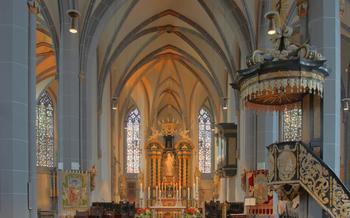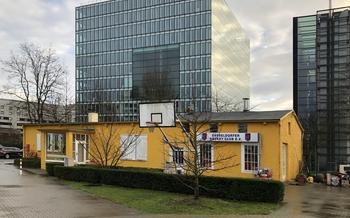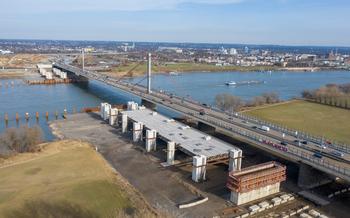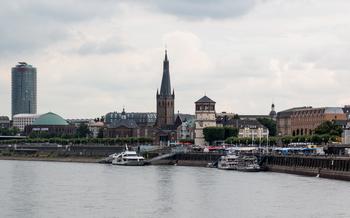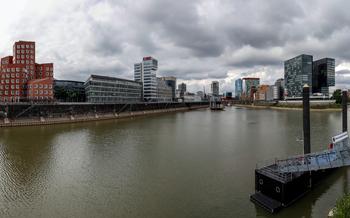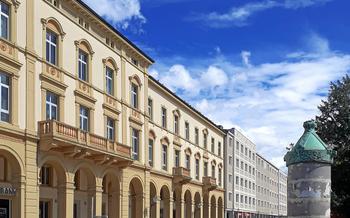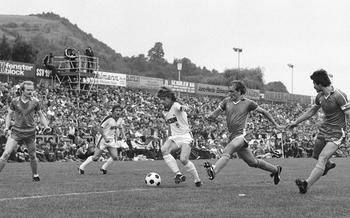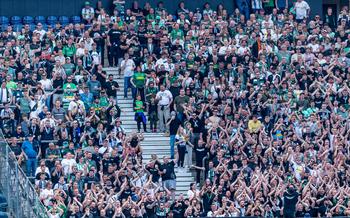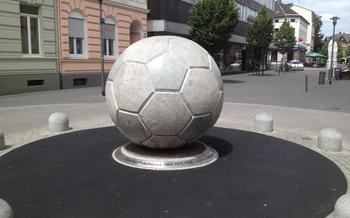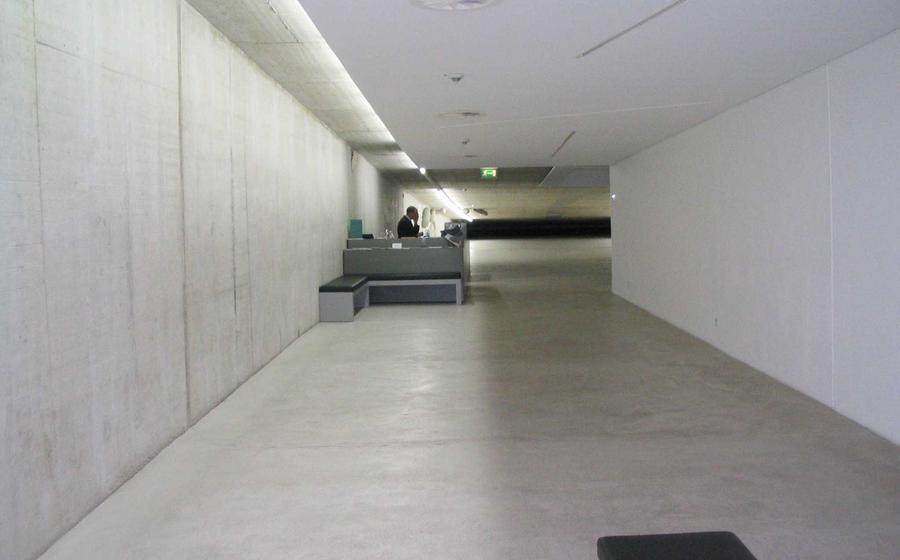
Kunst im Tunnel (KIT)
- Kunst im Tunnel (KIT): An Art Oasis in Düsseldorf
- Artistic Diversity at KIT
- Engaging with Art at KIT
- Exploring the Tunnel's Past
- Navigating the KIT Experience
- KIT's Impact on Düsseldorf
- Thematic Exhibitions at KIT
- KIT and the Local Community
- Behind-the-Scenes at KIT
- KIT in the Context of Düsseldorf's Art Scene
- KIT's Future Plans and Vision
- KIT for Art Enthusiasts: Tips and Recommendations
Kunst im Tunnel (KIT): An Art Oasis in Düsseldorf
In the heart of Düsseldorf, nestled beneath the bustling city streets, lies an extraordinary art space that has become a beacon of contemporary culture. Kunst im Tunnel (KIT), a former air-raid shelter transformed into a vibrant art gallery, invites visitors to embark on a journey through the realm of innovative and thought-provoking art.
KIT's story began in 1997 when a group of passionate art enthusiasts envisioned a unique platform for showcasing cutting-edge contemporary art. Their search for a suitable location led them to an abandoned tunnel, a relic of Düsseldorf's wartime past. With its raw, industrial aesthetic and evocative atmosphere, the tunnel seemed like the perfect canvas for their artistic vision.
Thus, Kunst im Tunnel was born, a gallery unlike any other. Its mission is to provide a space for artistic experimentation and dialogue, fostering a vibrant community of artists, curators, and art enthusiasts. KIT's focus on contemporary art reflects the city's dynamic cultural landscape, showcasing a diverse range of artistic mediums, from installations and sculptures to sound art and video projections.
In the world of Düsseldorf's art scene, KIT holds a significant position. It is a place where established artists can push boundaries and emerging talents can find a platform to showcase their work. KIT's unique location and innovative programming have made it a must-visit destination for art lovers from around the world.
Artistic Diversity at KIT
KIT's artistic offerings are as diverse as the artists it collaborates with. The space showcases a wide range of mediums, from traditional paintings and sculptures to experimental installations and multimedia works. Installations and site-specific creations are a particular focus, inviting visitors to engage with art in a unique and immersive way. KIT's exhibitions often feature collaborations with local and international artists, providing a platform for emerging talent and promoting cross-cultural exchange. With temporary exhibitions and rotating displays, visitors are constantly presented with new and thought-provoking works, ensuring that KIT remains a dynamic and ever-evolving art space.
Engaging with Art at KIT
Kunst im Tunnel (KIT) is not just a passive art-viewing experience; it actively invites visitors to engage with and participate in the artistic process. Interactive and immersive installations are a hallmark of KIT, blurring the boundaries between artwork and viewer. Visitors can become part of the artwork, manipulating elements, experiencing sensory effects, or even contributing their own creative input.
KIT provides opportunities for hands-on participation through workshops, events, and educational programs. These activities allow visitors to explore their own creativity, learn new techniques, and gain a deeper understanding of the artistic process. Workshops often focus on specific art forms or themes, such as printmaking, sculpture, or digital art. Events and performances range from live music and dance to poetry readings and artist talks, creating a vibrant and dynamic atmosphere in the tunnel.
KIT also serves as a platform for artistic experimentation and research. Artists are given the freedom to push boundaries, explore new concepts, and create site-specific works that respond to the unique qualities of the tunnel space. This encourages innovation and challenges traditional notions of art, leading to thought-provoking and groundbreaking exhibitions.
Exploring the Tunnel's Past
The tunnel that houses KIT has a rich and multifaceted history, adding depth and intrigue to the art space. Originally constructed during World War II as an air-raid shelter, it served as a refuge for Düsseldorf's citizens during the devastating Allied bombings. The tunnel's solid structure and strategic location beneath the city streets provided essential protection during air raids.
After the war, the tunnel lay dormant for several years, a silent reminder of a tumultuous period in history. In the 1980s, however, the city of Düsseldorf embarked on a visionary project to transform the former bunker into a unique art space. Recognizing the tunnel's potential as a cultural hub, they commissioned a group of architects and artists to reimagine the space.
The result was a remarkable transformation. The tunnel's raw, industrial aesthetic was carefully preserved, while its interior was redesigned to accommodate contemporary art installations. The architects ingeniously incorporated the tunnel's original features, such as the arched ceiling and exposed concrete walls, into the new design, creating a captivating backdrop for artistic expression.
Today, KIT stands as a symbol of resilience and creativity, a testament to Düsseldorf's ability to repurpose its past for the benefit of the present. The tunnel's unique atmosphere, with its echoes of history and the buzz of contemporary art, creates a truly immersive and thought-provoking experience for visitors.
Navigating the KIT Experience
Visiting Kunst im Tunnel (KIT) is an enriching and accessible experience for art enthusiasts of all ages. The tunnel is open from Tuesday to Sunday with extended hours on Thursdays. Admission is free, allowing everyone the opportunity to immerse themselves in contemporary art. Guided tours are available for groups and can be booked in advance. The tunnel is wheelchair accessible, ensuring that everyone can fully engage with the exhibitions.
To make the most of your visit, come with an open mind and a willingness to explore. Allow yourself time to wander through the tunnel, letting the installations and artworks captivate your senses. Take your time to read the descriptions and information provided about each piece, as they offer insights into the artist's intentions and the context of the work.
If you're interested in a deeper understanding of the exhibitions, consider joining a guided tour. Led by knowledgeable and passionate art historians, these tours provide exclusive insights into the curatorial process, the artists' backgrounds, and the significance of the artworks.
Photographers will find ample opportunities to capture the unique atmosphere of the tunnel and the artworks within. While flash photography is not permitted, the ambient lighting creates a dramatic and evocative backdrop for your shots.
Don't forget to check out the KIT Shop before you leave. It offers a curated selection of art books, prints, and souvenirs inspired by the exhibitions and artists featured at KIT.
KIT's Impact on Düsseldorf
Kunst im Tunnel (KIT) has played a pivotal role in shaping Düsseldorf's cultural landscape and contributing to its reputation as a vibrant arts hub. By providing a unique platform for contemporary art, KIT has attracted a diverse audience and fostered a thriving community of artists, curators, and art enthusiasts.
The tunnel's unique setting has served as an inspiration and a challenge for many artists, leading to the creation of innovative and thought-provoking works that have left a lasting impression on the city's cultural scene. KIT's commitment to showcasing international talent has also contributed to Düsseldorf's growing reputation as a center for contemporary art.
Beyond its artistic endeavors, KIT has collaborated with other cultural institutions and organizations in Düsseldorf, creating synergies and promoting cross-disciplinary collaborations. This collaborative spirit has enriched the city's cultural landscape and fostered a sense of community among artists and cultural practitioners.
Furthermore, KIT has played a significant role in promoting local artists and attracting international talent to Düsseldorf. The tunnel's reputation as a platform for cutting-edge contemporary art has made it a magnet for artists from around the world, contributing to the city's growing reputation as a vibrant and diverse art hub.
As a result of KIT's contributions, Düsseldorf has witnessed a surge in urban regeneration and cultural development. The tunnel's transformation from a wartime bunker to a thriving art space has become a symbol of the city's resilience and its commitment to embracing creativity and innovation.
Thematic Exhibitions at KIT
KIT's exhibitions are curated with a focus on exploring specific themes and issues that resonate with contemporary society. These themes can range from social and political concerns to environmental challenges and interdisciplinary collaborations. KIT's curatorial approach aims to provoke thought, stimulate dialogue, and foster critical engagement with the artworks on display.
Through its exhibitions, KIT has addressed topics such as migration, identity, globalization, and climate change. The exhibitions often feature works by local, national, and international artists, creating a diverse and thought-provoking dialogue on pressing issues. KIT collaborates with experts and institutions from various fields to ensure a comprehensive and interdisciplinary approach to the themes explored.
One notable exhibition, "SHIFTING PERSPECTIVES," examined the theme of migration and displacement through the lens of contemporary art. The exhibition featured works that explored the experiences of refugees, asylum seekers, and migrants, highlighting the challenges and opportunities of living in a globalized and interconnected world.
Another significant exhibition, "ECOSYSTEMS IN TRANSITION," delved into the impact of climate change on ecosystems and the environment. The exhibition showcased artworks that explored the interconnectedness of natural systems, the consequences of human intervention, and the urgent need for sustainable practices.
KIT's thematic exhibitions serve as a platform for discourse and critical thinking, encouraging visitors to engage with the artworks and reflect on the social, political, and environmental issues that shape our world.
KIT and the Local Community
Kunst im Tunnel (KIT) is not just an art space; it's also an integral part of the local community. KIT actively engages with local residents and businesses through various initiatives and projects. The tunnel's unique atmosphere and central location make it an ideal gathering space for people from all walks of life.
One of KIT's key initiatives is its community-based projects. These projects aim to foster creativity and artistic expression within the local community. KIT collaborates with local artists, schools, and organizations to create art projects that reflect the diverse voices and perspectives of the neighborhood.
KIT also hosts regular events and workshops that are open to the public. These events provide opportunities for people to engage with contemporary art, meet the artists, and participate in hands-on activities. KIT's educational programs also extend to children and families, offering art classes, workshops, and guided tours tailored to younger audiences.
Through these initiatives, KIT plays a crucial role in promoting social cohesion and fostering a sense of belonging within the local community. Art becomes a catalyst for dialogue, understanding, and collaboration, enriching the lives of both residents and visitors alike.
Behind-the-Scenes at KIT
Behind the scenes at KIT, a world of creativity and collaboration unfolds. The curatorial team works tirelessly to bring innovative and thought-provoking exhibitions to life. They collaborate closely with artists, providing support and guidance throughout the creative process. Working in a unique space like the tunnel presents its own set of challenges, requiring adaptability and ingenuity. The team must consider the technical aspects of installing artworks, ensuring their safety and integrity while preserving the tunnel's historical character.
Volunteers play a crucial role in KIT's success, generously donating their time and energy to support the curatorial team. They assist with everything from exhibition preparation to public outreach, ensuring that visitors have a seamless and enjoyable experience. Their dedication and passion are invaluable to KIT's operations.
KIT staff members have their own unique stories to tell, sharing anecdotes about the creative process, the challenges they've faced, and the triumphs they've celebrated. Their enthusiasm and commitment to KIT's mission are contagious, creating a vibrant and supportive work environment.
KIT in the Context of Düsseldorf's Art Scene
Kunst im Tunnel (KIT) occupies a unique position within Düsseldorf's vibrant art scene. While the city boasts a plethora of renowned art institutions, KIT distinguishes itself through its unconventional setting and focus on contemporary art. Unlike traditional museums or galleries, KIT offers an immersive and interactive experience that challenges conventional notions of art display.
KIT's unique location in a former wartime bunker adds to its allure, creating an unparalleled atmosphere that sets it apart from other art spaces. The city's rich artistic heritage is reflected in the diverse range of galleries, museums, and cultural institutions that call Düsseldorf home. Prominent among these are the Museum Kunstpalast, showcasing an extensive collection of art from the Middle Ages to the present day, and the NRW-Forum Düsseldorf, dedicated to contemporary art and media culture.
KIT collaborates closely with other art institutions in the city, fostering a sense of community and collective growth. These collaborations often result in joint exhibitions, events, and educational programs that enrich Düsseldorf's cultural landscape. The city's art scene is further enhanced by numerous private galleries, artist-run initiatives, and annual art fairs, contributing to a dynamic and ever-evolving artistic ecosystem.
Düsseldorf's international reputation as an art hub is cemented by its central location in the Rhineland region, which boasts a rich history of artistic patronage and cultural exchange. KIT plays a vital role in upholding this reputation by attracting renowned artists from around the world and presenting cutting-edge contemporary art that resonates with a global audience.
KIT's Future Plans and Vision
The Kunst im Tunnel (KIT) is constantly evolving and looking towards the future. With a dynamic team of curators and staff, KIT has ambitious plans to expand its reach and impact. Upcoming exhibitions will explore new themes and showcase cutting-edge contemporary art from around the world. Collaborations with other art institutions and organizations are on the horizon, promising exciting cross-disciplinary projects and events.
KIT is also committed to sustainability and environmental considerations. The tunnel's unique architecture and underground location provide opportunities for innovative and eco-friendly exhibition design. By incorporating sustainable practices into its operations, KIT aims to minimize its environmental footprint and contribute to a greener future for the art world.
Through its ongoing initiatives, KIT continues to shape the future of contemporary art in Düsseldorf and beyond. With a focus on inclusivity, experimentation, and social engagement, KIT remains a vital platform for artistic expression and dialogue. The coming years promise even more exciting developments as KIT pushes the boundaries of artistic creation and engages audiences in new and meaningful ways.
KIT for Art Enthusiasts: Tips and Recommendations
Navigating KIT's Art Labyrinth
Planning a visit to KIT is akin to embarking on an artistic adventure. To make the most of your exploration, consider these practical tips:
-
Plan Your Itinerary: Allocate ample time to fully immerse yourself in the tunnel's captivating installations. Allow at least an hour to wander through the tunnel, taking your time to appreciate each artwork's nuances.
-
Explore Different Perspectives: KIT's installations offer diverse vantage points. To capture the full essence of each piece, move around, explore different angles, and engage with the artworks from various perspectives.
-
Capture the Moment: KIT's unique atmosphere and intriguing installations provide ample opportunities for photography enthusiasts. Don't forget to bring your camera to capture the captivating visuals and share your experience with the world.
-
Discover Nearby Gems: KIT is nestled amidst Düsseldorf's vibrant cultural district. Take advantage of your visit to explore nearby attractions like the Kunsthalle Düsseldorf, KIT's sister institution, or stroll along the scenic Rhine River promenade.
